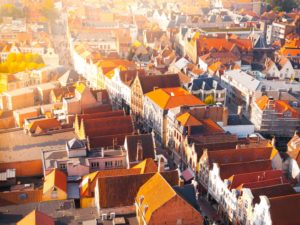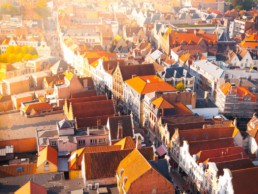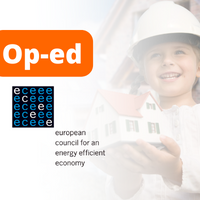Briefing 1/2019: Why Good Health Begins in a Good Homes
April 2018
Good health can come from many sources, but maybe none is as overlooked as the value of a good building.
We spend about 90% of our lives indoors. Most of the air we breathe over our lifetimes is found there. Our buildings’ temperatures, lighting, humidity, draughts and noise can determine our vulnerability to illness. They can even affect our moods and mental wellbeing. The World Health Organisation estimates that 4.3 million people die prematurely each year from exposure to indoor air pollutants.
Reams of studies on the subject have incontrovertibly linked healthy bodies to healthy buildings. There are many benefits to healthy schools, healthy hospitals, and healthy office buildings, as well as healthy homes.

Download the Renovate Europe Briefing 1/2019: Why Good Health Begins in a Good Home
Download the one-page infographic: Why should we carry out health renovations?
Renovate Europe reaches out to safeguard Energy Renovation in InvestEU

Ahead of the trilogues on InvestEU scheduled today Monday 18th and Wednesday 20th, Renovate Europe called on the negotiators to safeguard energy renovation of buildings as an explicit investment area in the Sustainable Infrastructure Window.
Indeed, article 7§1(a) should explicitly mention “(…) energy efficiency in line with the 2030 energy frameworks, buildings renovation projects focused on energy savings (…)” as in the Parliament position, supported by the Commission potential compromise text.
Buildings, whether schools, hospitals, police stations, or houses and apartments, are an essential infrastructure in Europe, providing a shelter and a nest to our citizens. They must be renovated in an energy efficient manner to give comfort and wellbeing, ensuring good health for everyone. Funding building renovation is an essential investment in our infrastructure. When we renovate buildings, we are investing in the future safety, productivity and prosperity of the EU. As any other infrastructure, buildings require investment and renewal in order to stay effective and competitive.
This clarification of eligibility would help mobilise financing by bundling projects together, building a pipeline of projects, and giving confidence to investors and the private sector. This would be especially important given that in some Member States, between 40 and 80% of public infrastructure investment comes from the EU Budget.
Op-ed: Time to address Europe’s hot and cold homes crisis (Euractiv)
Published by Euractiv on: 20 February 2019 | Most European countries have significant energy poverty problems and are unable to keep their citizens warm during winter. In fact, that applies as much to cooling as to heating, writes Adrian Joyce.
Op-ed: Commission must not take its eye off the ball for decarbonisation by 2050 (Euractiv)
Published by Euractiv on: 28 November 2018 | The European Commission will need clarity, nerve and vision to chart a decarbonisation path to 2050 that addresses the nearly 40% of Europe’s emissions that currently come from buildings, writes Adrian Joyce.
Op-ed: Efficiency or economy? We can have both… or neither (ECEEE)
Published by ECEEE on: 22 November 2018 | Energy efficiency and a strong economy are sometimes counterposed against each other as if they were a zero-sum choice. “It’s all very well touting luxury renovations, but in the real world investors need a return,” discordant voices will say. The International Energy Agency’s Energy Efficiency 2018 Outlook study is a useful corrective to this position – so useful in fact, that its neglect in the media was quite shocking.
Why the indoor renovation ripple effect could save our lives

By Adrian Joyce, Renovate Europe Campaign Director
22nd November 2018
Christmas is not just a time of mistletoe and wine with the family. It’s a time of coughs, sneezes and wheezes as the temperature drops. One reason for this is that we spend so much time indoors. On average, we spend more than 21 hours of each day inside buildings and the colder it is outside, the more likely we are to be curled up on a warm sofa – and exposed to particles, mould and bacteria. It is counter-intuitive but concentrations of air pollutants indoors can be up to five times greater than those outside.
Temperature, draughtiness, light and noise also play an outsized role in our wellbeing. But buildings can still be overlooked or underestimated. They are simply too close to home, and as scantly noticed as the air that we breathe.
However, a new ‘Buildings 2030’ report by the Buildings Performance Institute Europe (BPIE) is shining a spotlight on it. For the first time, the study measures and quantifies the extraordinary effects that energy renovations can have on wellbeing and productivity in schools, offices and hospitals.
The report’s headline figures are eye-catching. Europe’s students could shave two weeks off their school year with better indoor air quality. Hospital patients’ recovery time can be abridged by 10 % (about a day per person), with savings of up to €50 billion. Most impressively, workplace productivity could soar with benefits worth as much as €500 billion Europe-wide.
The reasons why are not hard to fathom. Poor air quality is a drain on human resources. Too much warmth causes tiredness and inattentiveness. Too much cold fuels asthma, allergies and headaches. High levels of carbon dioxide, nitrogen dioxide, ozone and volatile organic compounds can create sick building syndrome and trigger a range of ailments.
The International Study of Asthma and Allergies in Childhood has found the prevalence of such maladies rising among European children, linked to poor indoor and outdoor air quality. But the ripple effect from energy renovations could change all that.
Clear lighting – including daylighting – can raise feelings of freshness, creativity and productivity in a workforce. The opposite is also true. Poor lighting leads to eye strain, headaches, bad posture and more frequent accidents.
Noise is another under-rated aspect of the quality of life. Good acoustic indoor environments reduce stress and aid calmness, concentration and responsiveness. When noise insulation is poor, diminished cognitive performance, and reduced concentration and memory all too often result.
The BPIE study found that where the best indoor environment aspects were aligned, workers were less drowsy, healthier, more alert, focussed and productive, and with higher morale.
This could also be quantified in reduced rates of absenteeism, lower staff turnover and fewer business disruptions.
Altogether, the average employee’s improved annual performance was worth between €1,000 and €6,500, the BPIE found, after extrapolating from hundreds of reports. For an office of 200 people that would translate to annual savings of around €600,000. For Europe as a whole, it would amount to around €500 billion per year gross value added – as much as the Juncker Commission set out to leverage in its flagship EFSI programme over the five-year life of this Commission.
Students would enjoy their time inside buildings more if the air quality were better. In warmer, drier and better ventilated schools, children are present more often and take fewer sick days off, resulting in less overall spending on healthcare.
For those already in healthcare facilities, high quality indoor spaces reduce the average patient’s stay in hospital by around 1 day, the BPIE paper says. This slashes financial overheads and frees up staff time, improving access to resources for health services.
Most importantly, faster recovery times from illnesses improve the quality of life for all and, in common with other multiple benefits from energy renovations, do so for a fraction of the cost of treating the maladies.
“The cost of renovating these buildings is modest compared to the many benefits, including healthier, happier and more productive citizens,” says the study. “An enhanced building stock will facilitate a better quality of life and a more competitive European economy.”
So, what are we waiting for?





